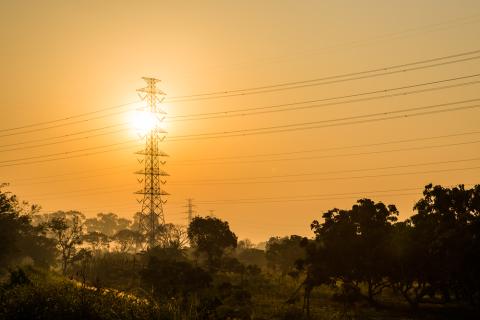IEEFA update: Get out now — Norway’s fossil fuel epiphany
Norway’s Government Pension Fund Global (GPFG), the world’s largest sovereign wealth fund, has decided to “sell.” They have announced plans to divest from 134 oil and gas exploration and production companies held in its US$1 trillion investment fund. The fund will continue — at least for now — to hold onto the stocks of large, major oil and gas companies like ExxonMobil, Total S.A. and Chevron.
Norway’s national decision: start worrying
Henrik Asheim, a leader of Norway’s Conservative Party, supported the move, saying “It’s not a debate about climate. It’s about financial risk.”
Divestment is in Norway’s national interest
The decision is a pragmatic move by Norway to protect itself. The government owns, extracts and sells oil and gas. For decades, annual profits have been used to balance the national budget and build an investment fund. However, the low-price environment that plagues today’s industry globally has led Norway to accept that annual revenues are in a permanent decline. The fund was created because the nation’s leaders knew that someday the financial gains from oil and gas would run out. That someday is coming. Soon.
The revenue slide from oil and gas is considerable, and imminent. It already requires that Norway’s annual budget draw down on the fund principal. This is a red flag not only for the fund, but with wider warnings for the country’s fiscal and economic health and stability. Norway is well-positioned to handle the problem – for now. But the government must find replacement revenue, which means new revenue-generating industries are needed. To Norway’s credit, it is addressing this long-term challenge now.
Norway invests in oil and gas companies throughout the world. Further, the country’s big-picture economic and fiscal situation does not fully explain why the fund should divest from the oil and gas exploration and production sector. What, then, is the rationale for divestment?
The government has decided it has about ten years left of profitable drilling on the continental shelf. It will use this time to squeeze every last ounce of oil out of the earth and every last krone out of its customer base. Many governments and companies also have the same ten years of remaining time. So, why is the Norwegian fund divesting now? And why is it divesting from companies doing business outside of Norway?
The Norwegian explanation treads gingerly on the issue of oil price dynamics and volatility and eschews grand pronouncements about the status of the declining petroleum sector. For sure, low oil prices, competition from renewable energy and climate issues all play a role. But they are being deemed as more or less manageable by fund managers.
The fund management analysis also ignores the paradox facing the companies targeted for divestment. Most are part of the investment juggernaut that is driving the fracking boom. Fracking technology lowers extraction costs and has resulted in production growth at historic levels. The resultant oversupply has driven down prices to the point where oil and gas producers are struggling to make a profit. The Wall Street Journal has written nearly a dozen articles over the last two years chronicling the many ways in which the business model for unconventional fossil fuel production is untenable, requiring ongoing cash investments that exceed any proceeds made from drilling and selling oil and gas.
Oil and gas sector is no longer reliably profitable
The genteel and nuanced language used by the fund masks something fundamental. The Norwegian fund is getting out of oil and gas exploration and production because the sector is not producing reliable positive cash flows, and is no longer dependably profitable and is becoming increasingly less so. Norway’s leaders understand better than most that a low oil price environment puts a lid on any new, expensive, hard-to-get reserves. Yes, there is ten years or so of supply left. But the truth of the matter is that the fracking business and more expensive oil reserves will bring with them a sea of trouble. From the perspective of a sovereign fund or an actuary managing a country’s fund, ten years is short-term. The fund’s conclusion: Get out now. Norway’s national decision: Start worrying.
Norway’s Ministry of Finance makes clear that the loss of these stocks from the portfolio will have no negative impact on the fund’s financial performance, and may even improve its returns. The divestment will eliminate the short- and long-term risks related to price, volatility, supply and climate. When a major financial risk is eliminated, the quality of an investment tends to improve.
Norway’s strategy does not end with its divestment from the weakest link in the energy sector. In fact, their fund managers have decided to hold onto investments in the oil majors, the largest global private oil companies. They offer an interesting explanation for this. They see how market forces are driving large oil majors toward renewable energy and want Norway to be part of that growth story. This is a smart, rational response. The dumb money is in oil and gas, and the smart money is pivoting.
The not-so-rational response to stick with fossil-fuel-forward policies can be found in the board rooms of most oil and gas majors and the capitols of oil producer nations. Some of them, such as ExxonMobil and Chevron, want nothing to do with renewable energy. They are expanding capital plans and continue to roam the world and drill despite the sector’s recent history of bad bets and lost value. Many are continuing to bet their future returns on significant investments in fracking and oil sands, the very same ventures the Norwegian fund is divesting from.
Norway’s fund managers CAN COUNT. The short-term, cold reality tells them that the larger oil majors are more likely to continue to provide cash dividends from oil and gas for the foreseeable future. The oil majors will do this as they steadily burn through their shrinking asset base.
A global financial picture emerges
The fund’s statement is cautious. It limits its rationale to Norway’s national interest, oil and gas ownership and fiscal burdens. The analysis nevertheless sheds light on the current and future state of the global oil and gas market and offers some other important lessons for investors.
-
- Fracking economics are a bust. Divesting from oil and gas exploration and production is a very strong statement, and should serve as a warning to all. Fracking technology can produce large amounts of oil and gas, but a market-based business model has proven elusive. The 134 companies selected for divestment are largely pure-play actors investing in unconventional exploration and production. IEEFA has produced three studies that track 30 of these companies and our conclusion has been that they are not producing – and never have produced – free cash flow, even during years of relatively high oil prices. Improvements in the sector’s cash position are likely to be modest.
Within the fracking industry, a larger trend is occurring toward concentration and increasing investment by Big Oil. These companies’ massive asset bases are being used to manage the financial risks of unconventional oil and gas drilling. Traditional high-yield debt and equity investors have grown weary of losing money with their poor-performing investments in smaller fracking-focused companies.The list of companies provided by the Norwegian government also contains a host of oil sands producers in Canada, a reminder that the loss in investor confidence in the sector continues to reverberate. - The big oil majors are suspect. The Norwegian fund is not running away from the majors – for now. The fund has indicated they are holding onto these investments to take advantage of future earnings from renewable energy. In its final legislative action approving this decision, the Storting (the Norwegian parliament) should require its remaining oil major investments to produce viable business plans to show how they intend to pivot away from fossil fuel development. Those that fail to pivot should join the list of companies the fund divests from. Such a move would provide operational teeth to the divestment decision.
- Renewable energy industries create global benefits. Half-way through the Finance Ministry’s write-up is a revelation that should give every investor pause. While concerned about the impact of declining oil demand on Norway’s business sectors that service the industry, the Finance Ministry makes the following statement: “Other industries may, at the same time, experience an increase in demand, depending inter alia, on the impact of a lower oil price on the world economy and the Norwegian krone exchange rate.”
At the risk of stating the obvious, given the choice, rational markets choose cheap over expensive! A country or fund looking beyond oil and gas for new drivers of the world economy must look at the underlying factors that are pushing capital away from this once-powerful sector. The replacement for oil and gas is coming largely from technological forms of energy production driven by zero-cost fuels. A core assumption of the oil and gas sector is that energy must be expensive and it must become more expensive to fuel economic growth. The markets are proving otherwise. Permanent and relatively stable low-energy prices offer a growth trajectory – but one very different from the past.
The fracking business will bring with it a sea of trouble
Who will follow Norway’s lead?
Many are asking whether Norway’s investment decision will influence other large funds to follow suit. It should.
There are other questions too. Norway has acknowledged that its national interest is now decoupled from fossil fuel growth and that a public debate about its economic future is necessary. Will this realization catch on in other countries? Many countries (and companies) have oil and gas reserves. But what are these reserves now worth in a low-price environment where new forms of energy offer competitive, permanent alternatives?
This is not an easy discussion. Most political leaders in democratic countries that depend on oil and gas for economic health are avoiding this debate, making believe it is not happening. In Canada, the Trudeau government believes a blank check from taxpayers for the Trans Mountain Pipeline will bolster the crippled oil sands sector. In Argentina, the government has embarked on a fiscally perilous gamble to continue subsidizing global oil companies as a way of developing the country’s oil and gas reserves in Patagonia (Vaca Muerta). The U. S. government is blind to changes in the fossil fuel sector and hostile to new energy investment.
Public debate in these countries is also taking on anti-democratic characteristics that very much mimic the leading oil-rich authoritarian countries. Russia, Saudi Arabia and other countries use state-sanctioned violence and intimidation against activists and journalists to make sure a debate about the economic future does not take place in public. To allow debate might expose not only the historically corrupt and incompetent use of oil profits for personal gain and political domination, but might also highlight the need for new, transparent economic arrangements–matters too sensitive for regimes where legitimacy is fragile.
The Norwegian government made the decision over thirty years ago to use annual profits from oil and gas development to secure the well-being of its people. They threw an anchor into the future and the plan has largely been a success. But, as market realities in Norway and around the world show us, the organizational, political, environmental, legal, financial and economic rules of the road have changed. New rules must be written or the people and institutions involved will suffer accordingly. Norway’s leaders have taken a bold decision on fossil fuels. More importantly, they have come to believe that they had no other choice.
Kathy Hipple is an IEEFA financial analyst, [email protected]
Tom Sanzillo is IEEFA’s director of finance, [email protected]
Related Items
IEEFA update: Norway’s recognition of a declining oil and gas sector sends a message
IEEFA update: Norway moves to invest in unlisted renewable energy
IEEFA update: Norway shows what to do with fading oil and gas holdings
- Fracking economics are a bust. Divesting from oil and gas exploration and production is a very strong statement, and should serve as a warning to all. Fracking technology can produce large amounts of oil and gas, but a market-based business model has proven elusive. The 134 companies selected for divestment are largely pure-play actors investing in unconventional exploration and production. IEEFA has produced three studies that track 30 of these companies and our conclusion has been that they are not producing – and never have produced – free cash flow, even during years of relatively high oil prices. Improvements in the sector’s cash position are likely to be modest.













